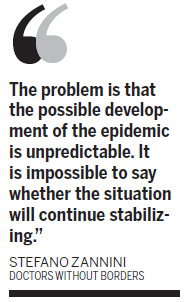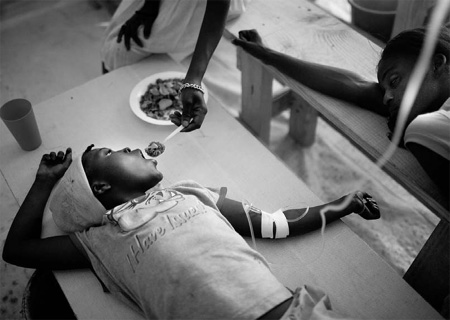Top News
Cholera takes a breather in Haiti, but could surge again
Updated: 2011-01-25 07:57
By Ben Fox (China Daily)
|
Janika Faneus is fed by her mother while receiving treatment for cholera at a Doctors Without Borders cholera clinic in Haiti. Rodrigo Abd / Associated Press |

SAINT-MARC, Haiti - The cholera epidemic that has raged across the country is claiming fewer victims, with a sharp drop in new cases everywhere from the shimmering rice fields of the Artibonite Valley to the crowded urban slums.
It is a welcome development, but tinged with doubt: It's not yet known whether the epidemic that has killed nearly 4,000 people is fading or merely taking a break, only to surge again perhaps with the onset of the next rainy season.
"The general situation is improving. It's clear," Stefano Zannini, chief of mission for the aid group Doctors Without Borders, said. "The problem is that the possible development of the epidemic is unpredictable. It is impossible to say whether the situation will continue stabilizing."
Any progress on controlling the disease would be rare bit of good news for Haiti, which is passing through a particularly gloomy period. The country is on edge amid a political crisis over a disputed presidential election, and could see more of the violent protests that paralyzed cities and hampered cholera treatment in December. Meanwhile hundreds of thousands are still homeless from last year's earthquake, and a much-reviled former leader suddenly returned and took up residence in the past week.
Zannini, whose group is contemplating scaling back its more than 40 cholera treatment centers, was unable to muster even cautious optimism regarding the disease. The best he could say was that he was happy new cases and deaths are decreasing to levels not seen since soon after the disease emerged in October.
"I would not be optimistic," he said.
For the moment, at least, the statistics are moving in the right direction. The number of new cases has dropped to about 4,700 per week, down from more than 12,000 per week in November, and the trend is downward in all 10 of Haiti's departments, or regions, according to the Health Ministry's latest bulletin, released on Thursday. The only places it appears to be still rising are in a few isolated spots in the northwest and south.
Some 40 patients a day are still coming to the Doctors Without Borders treatment center in Saint Marc, where the disease first exploded, but that's a third of what it was in December and there hasn't been a death in six weeks, said field coordinator Oscar Sanchez Rey.
"Is this is the end? Nobody really knows, but the situation is better," Sanchez said as he took a break from treating patients, including a family of six that all came down with the disease together. He cautioned that even though fewer people are getting sick, the center's work is still critical: "If no one is treating patients, they are going to die, because it's a lethal disease."
Lilane Estime, 42, tried to sleep on a wooden bench as doctors attended to three of her children. She said all four had piled onto a motorcycle taxi and traveled an hour along a dusty coastal road to reach the clinic. Seemingly healthy, she said she could feel cholera inside her, though she hadn't gotten sick yet.
"If there's a disease going around killing people, you're going to be scared," Estime said.
In Cite Soleil, the dense slum at the northern edge of Port-au-Prince, the number of new cases is now about 15 per week, down from a high of 700, and there are similar reports from nearby neighborhoods. In the hard-hit Artibonite Valley, the weekly new caseload is about 700, compared with more than 4,800 in November.
"We don't want to say, 'OK, cholera is finished', because it's not," said Cinta Pluma, a spokeswoman for the aid group Oxfam. "But it does seem to be going down."
Caused by a bacteria that spreads through contaminated water, the disease so far has sickened more than 194,000 people and killed about 3,890 nationwide. It can lead to a rapid, painful death through complete dehydration, but is easily treatable if caught in time.
In December, UN Secretary-General Ban Ki-moon warned the outbreak could affect as many as 650,000 people over six months, but that seems less likely now. The Pan-American Health Organization still projects cholera will sicken about 400,000 people over a year.
The UN Food and Agriculture Organization warned in December that cholera would also worsen hunger in the impoverished nation. Surveys showed workers in the Artibonite, Haiti's main agriculture zone, were afraid to wade into rice fields and the public was shunning the region's produce, causing steep price drops in the local street markets. Jackson Dorgil, an FAO agricultural technician in the area, said prices for staple crops such as onions, tomatoes and melons plummeted - and much couldn't be sold at all.
But that too seems to have improved. At the region's main market in Pont-Sonde on Saturday, prices and sales were back to normal, with hundreds of women selling produce, fish and other products in neat little pyramids spread over burlap sacks. "Life is starting to be normal again," Dorgil said during a tour of the region.
Rice fields there were filled with barefoot workers up to their ankles in muddy water believed to be contaminated with the cholera bacteria, planting the crop under a blistering sun. Most earn about $2.50 for a six-hour workday.
Fresnel Louis, the president of a worker's association in the area, said radio commentators were warning people not to go into the water at the start of the outbreak, but there were few options.
Associated Press
(China Daily 01/25/2011 page11)
Specials

President Hu visits the US
President Hu Jintao is on a state visit to the US from Jan 18 to 21.

Ancient life
The discovery of the fossile of a female pterosaur nicknamed as Mrs T and her un-laid egg are shedding new light on ancient mysteries.

Economic Figures
China's GDP growth jumped 10.3 percent year-on-year in 2010, boosted by a faster-than-expected 9.8 percent expansion in the fourth quarter.
